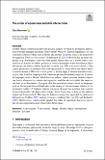| dc.contributor.author | Newman, Elise | |
| dc.date.accessioned | 2024-07-09T20:16:08Z | |
| dc.date.available | 2024-07-09T20:16:08Z | |
| dc.date.issued | 2024-07-02 | |
| dc.identifier.issn | 0167-806X | |
| dc.identifier.issn | 1573-0859 | |
| dc.identifier.uri | https://hdl.handle.net/1721.1/155551 | |
| dc.description.abstract | Double object constructions provide an ideal context in which to investigate interactions between multiple instances of movement. With two internal arguments, we can construct scenarios where one A-moves and another Ā-moves, such as in the passive wh-question What was Sue given? Holmberg et al. (2019) observe that in many languages (e.g. Norwegian) that otherwise permit either object of a double object construction to A-move to subject position, a restriction emerges when the indirect object wh-moves: the indirect object must also A-move (e.g. Who was given a book?). One cannot pronounce an indirect object wh-question in a clause where the direct object A-moves instead (*Who was a book given?). In this paper, I observe that this restriction is only found in languages that otherwise permit the indirect object to A-move. In languages such as Greek, which have no indirect object passives, indirect objects can freely wh-move in a direct object passive, and thus do not exhibit the same restriction as in Norwegian. I propose that this restriction comes about in languages such as Norwegian but not Greek due to the timing of wh-movement relative to A-movement within vP. Indirect objects wh-move through the position that controls A-movement early, blocking a direct object from A-moving, so long as the indirect object can A-move itself. The analysis features a smuggling approach to passives of ditransitives (Collins 2005) and an economy condition like van Urk and Richards’ (2015) Multitasking, which jointly predict the order of operations that gives rise to the wh-movement restriction observed in Norwegian. | en_US |
| dc.publisher | Springer Science and Business Media LLC | en_US |
| dc.relation.isversionof | 10.1007/s11049-023-09611-3 | en_US |
| dc.rights | Creative Commons Attribution | en_US |
| dc.rights.uri | https://creativecommons.org/licenses/by/4.0/ | en_US |
| dc.source | Springer Netherlands | en_US |
| dc.title | The order of operations and A/Ā interactions | en_US |
| dc.type | Article | en_US |
| dc.identifier.citation | Newman, E. The order of operations and A/Ā interactions. Nat Lang Linguist Theory (2024). | en_US |
| dc.contributor.department | Massachusetts Institute of Technology. Department of Linguistics and Philosophy | |
| dc.relation.journal | Natural Language & Linguistic Theory | en_US |
| dc.identifier.mitlicense | PUBLISHER_CC | |
| dc.eprint.version | Final published version | en_US |
| dc.type.uri | http://purl.org/eprint/type/JournalArticle | en_US |
| eprint.status | http://purl.org/eprint/status/PeerReviewed | en_US |
| dc.date.updated | 2024-07-07T03:10:53Z | |
| dc.language.rfc3066 | en | |
| dc.rights.holder | The Author(s) | |
| dspace.embargo.terms | N | |
| dspace.date.submission | 2024-07-07T03:10:53Z | |
| mit.license | PUBLISHER_CC | |
| mit.metadata.status | Authority Work and Publication Information Needed | en_US |
